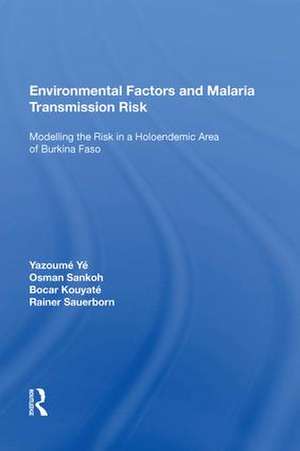Environmental Factors and Malaria Transmission Risk: Modelling the Risk in a Holoendemic Area of Burkina Faso
Autor Yazoumé Yéen Limba Engleză Paperback – 12 oct 2020
Preț: 380.69 lei
Nou
Puncte Express: 571
Preț estimativ în valută:
72.90€ • 74.40$ • 61.34£
72.90€ • 74.40$ • 61.34£
Carte tipărită la comandă
Livrare economică 25 februarie-11 martie
Preluare comenzi: 021 569.72.76
Specificații
ISBN-13: 9781138619579
ISBN-10: 1138619574
Pagini: 166
Dimensiuni: 156 x 234 x 9 mm
Greutate: 0.31 kg
Ediția:1
Editura: Taylor & Francis
Colecția Routledge
Locul publicării:Oxford, United Kingdom
ISBN-10: 1138619574
Pagini: 166
Dimensiuni: 156 x 234 x 9 mm
Greutate: 0.31 kg
Ediția:1
Editura: Taylor & Francis
Colecția Routledge
Locul publicării:Oxford, United Kingdom
Cuprins
Contents: Preface; Part 1 Introduction; What is malaria? How is it transmitted?; Malaria epidemiology and economic burden; Risk factors for malarial transmission; Fighting malaria; Rationale of the study; Study questions and objectives; Conceptual framework. Part 2 Population, Material and Methods: Study design; Study sites; Malaria infection survey; Entomological survey; Weather data; Data processing; Data analysis; Ethical considerations. Part 3 Results: Characteristics of the study population; Outcome of follow up; Fever and p. faciparum infection status; Weather variation in the 4 sites; Effect of weather on p. falciparum infection; Mosquito population dynamics; Weather-based dynamic model of malaria transmission. Part 4 Discussion and Conclusions: Discussion; Conclusion; References; Annexes: Index.
Notă biografică
Yazoumé Yé African Population and Health Research Centre, Kenya. Osman Sankoh INDEPTH Network, Ghana. Bocar Kouyaté Centre National de Recherche et de Formation sur le Paludisme, Burkina Faso. Rainer Sauerborn University of Heidelberg, Germany.
Descriere
The fifth Millennium Development target of reducing infant mortality by two thirds by the year 2015 can only be achieved if mortality due to malaria is significantly reduced. This book addresses this issue by developing a dynamic malaria transmission model at a local (district) scale using appropriate environmental factors.
